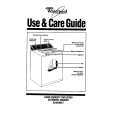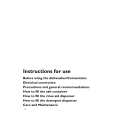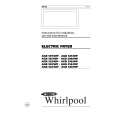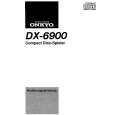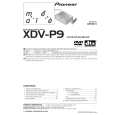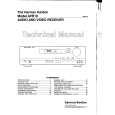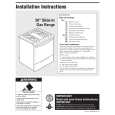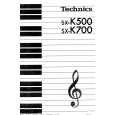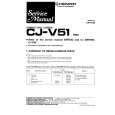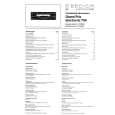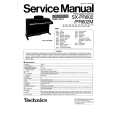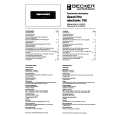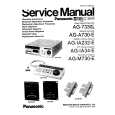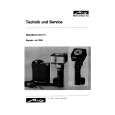|
|
|
Productos
|
|
Información
|
|
Destacado
|
|
|
 |
|
|
No hay comentarios de productos.
surround level is low, then the Surround Volume control should be turned up to achieve the effect intended by the 6lmmaker. Sometimes the display can also inform the listener of poorly mixed program material, for instance, by indicating signals in the surround speakers when only front channel dialogue should be heard. *In the bypass modes (Mono and Stereo Surround Synthesis Defeat), the display should not be used as a guide to levels or locations.
@ R M T CONTROL E OE
The Remote Control allows convenient, wireless adjustment from the listening position of the Master and Surround volume controls to suit each individual tape, disc, or broadcast. Pressing the "+" end of either the Master Volume or Surround Volume switch bar will cause the corresponding control on the HE5300 to rotate clockwise; pressing the - " end will cause counterclockwise rotation. Once the end stop is reached, further pressing on the bar will have no effect on the output. Pressing the Mute button will reduce the overall volume to a very low level, as indicated by the lighted red Mute LED @ on the HTS5300; pressing the Mute button again will restore the volume and turn off the Mute LED. If you hold the Mute button down for three seconds or more, you will turn on the Noise Sequencer. For the use of this feature, please see the section on Balance and Phasing. If you accidentally activate the Noise Sequencer, turn it off by pressing the Mute button. The Remote Control system uses invisible infrared energy for transmission of control signals. This energy is radiated from the Remote Control over a wide angle from the front of the unit, making it generally unnecessary to aim it directly towards the HTS5300. A green LED @on the Remote Control indicates that a control signal is being transmitted, while the green Remote LED @on the HTS5300 shows that the signal is being received. In general, the Remote Control system wdl work properly if the HTS5300 is positioned anywhere in the room so that its wide-angle Remote sensor @can "view" the walls and other reflective surfaces. For best results, avoid placing the HTS5300's sensor in direct sunlight or other very bright light. The Remote Control contains a 9-volt alkaline battery (Duracell MN1604, Eveready 522, or equivalent) for power. Intermittent or improper control action may indicate the need for its replacement (see Troubleshooting section). Recommended inital settings of Remote Surround and Master Volume: Same as Recommended Levels for front panel Surround and Master Volume above.
"
Dl AV D2 IN VARIOUS ROOM CONFIGURATIONS JD FIGURE 7 calculating the optimum Digital Delay setting in rooms of various shapes. (Other delay times may be preferred by some listeners.) The final setting should cause the rearmost listener to hear center-screen speech coming from the front of the room. Never £rom the rear. Recommended initial setting: 20ms
@~urround Volume and @ Master Volume: Use these controls to set a first approximation to the final listening level desired. The Master Volume control adjusts the volume of all (six, five, or four) output channels used. The Surround control adjusts the level of the rear channels, thus permitting the listener to achieve the desired front/rear balance in the sound field. NOTE: Output trim controls (see Figure 12) are available underneath the unit for cases where front and rear amplifiers and/or speakers differ so much in power or efficiency that the Master and Surround Volume controls do not provide the desired relative levels. See the instructions for System Balance. Recommended initial settings: Start with the Surround control at higher levels than you might imagine desirable; then back off until satisfactory levels are reached. Starting at a low level and advancing the control may lead the listener to stop adjustment before the optimun level has been attained.
GRAPHIC DS L Y IP A The display shows the relative levels of the decoded and processed output at the front and surround channels in the Dolby Surround and Surround Synthesis modes*. The display is independent of the Volume and Surround Level control settings. The graphic display is used to check initial setup of the HTS5300 Acra-Vector Logic Decoder and the HTS Reference System; to confirm that left channel outputs do appear at the left speaker for example. Listening and experimentation will demonstrate the display's usefulness in educating the ears to the appropriate Master and Surround Levels for various performances. If, for instance, surround channel outputs are displayed very brightly but the aurally evident
R M T E T N E (not illustrated) E OE XE DR Use this optional accessory HTSGORX when the HTS5300 is located in a closed cabinet or out of view of room surfaces. Connect the 2.5 mm plug from the HTSGORX to the REMOTE SENSOR jack on the HTS5300 back panel. The supplied cord is 9.1 m (30 ft) long permitting wide latitude in locating the HTS5300. If still greater distance from the HTS5300 is required, extension cable up to a length of 30 m (100 ft) additional is permissible. The very small size and unobtrusive appearance of the HTS6ORX make it easy to find an appropriate location for it, while its weighted bottom and non-skid feet make it stable on most surfaces. NOTE: While the Remote Sensors on the HTS5300 and the HTS6ORX are relatively insensitive to ambient bright light, we recommend that both be kept out of direct sunlight. No setting required: Just plug in and use.
|
|
 |
> |
|



